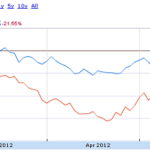Romney’s choice of Paul Ryan for vice president will influence more than public policy. The next leader of the free world will have a huge impact on Wall Street.
What’s at Stake
The politics may be about jobs, but the bigger issues only affect a few key sectors and asset classes. Here are two focal points in the upcoming election:
- Health care – If Mitt Romney and Paul Ryan score a victory in November, health care will be a hot topic. One has to question the possibility of overturning Obamacare, but changes are certain to other programs like Medicare and Medicaid. Both Romney and Ryan support returning control of Medicare and Medicaid to the states, which could potentially restrict the free flow of cash from Uncle Sam’s bank account.
- US Treasuries – The United States has a deficit and debt problem. So far, trillion-dollar deficits have been funded almost entirely by the Federal Reserve. Since 2008, the Federal Reserve’s balance sheet grew from $900 billion to $2.8 trillion, most of which can be attributed to the purchase of agency mortgage-backed securities (guaranteed by the US government) and US Treasury securities. Should a Romney-Ryan ticket get serious about deficit and debt reduction, US Treasuries would naturally rally as investors become more confident about Uncle Sam’s creditworthiness. See the following chart to see just how quickly the Fed’s balance sheet exploded.

How to Play the Presidency with ETFs
- 30 Million New Customers – The biggest winners from Obamacare are health insurance companies and pharmaceutical firms. The law guarantees customers for health insurance companies, especially in very profitable, low-risk insurance for younger health care consumers. To play health insurance, look no further than the Dow Jones U.S. Health Care Providers Index (IHF). Don’t be fooled by the name, many health care providers provide risk services whereby they accept patients for a flat rate in exchange for the surplus beyond the cost of providing care. The fund holds 46 companies and trades with a low annual expense of .48% per year.
- More Pills – The pharmaceutical industry has a whole lot to celebrate: the most profitable health care market in the world just became more profitable. With 30 million new insurance customers by 2014, pharmaceutical companies will enjoy plenty of new customers for already paid-for product lines. Look to an exchange-traded fund like the Dow Jones U.S. Pharmaceutical Index (IHE) which diversifies investors’ assets between 38 different, well-known pharmaceutical companies for a low .48% annual expense.
- Less Debt? – Mitt Romney has made the deficit a number two issue behind job creation, but Paul Ryan is no stranger to controversial budget slashing. What is proposed rarely comes to fruition, however a slice of any size could substantially reduce US debt issuance going forward, further driving down interest rates. You’ll want to go long on the yield curve; the Vanguard Long-Term Government Bond Index (VGLT) can help you do just that. Filled with a selection of US government securities with maturities of greater than 10 years, this mix provides a stable yielding fund that offers upside should the US get serious about deficit reduction. It should also keep losses to a minimum if the Fed’s 30-year bond buying spree comes to a close. The fund is one of the least expensive ways to play a balanced blend of maturities at .14% per year.  And in the event of a loss and/or further deterioration of the outlook on America’s ability to repay their debt, you could always try shorting Treasuries with ETFs.
Disclosure: No position in any ETFs discussed here.










{ 0 comments… add one now }